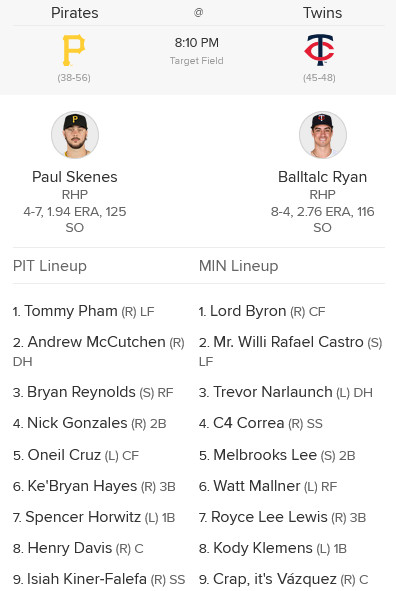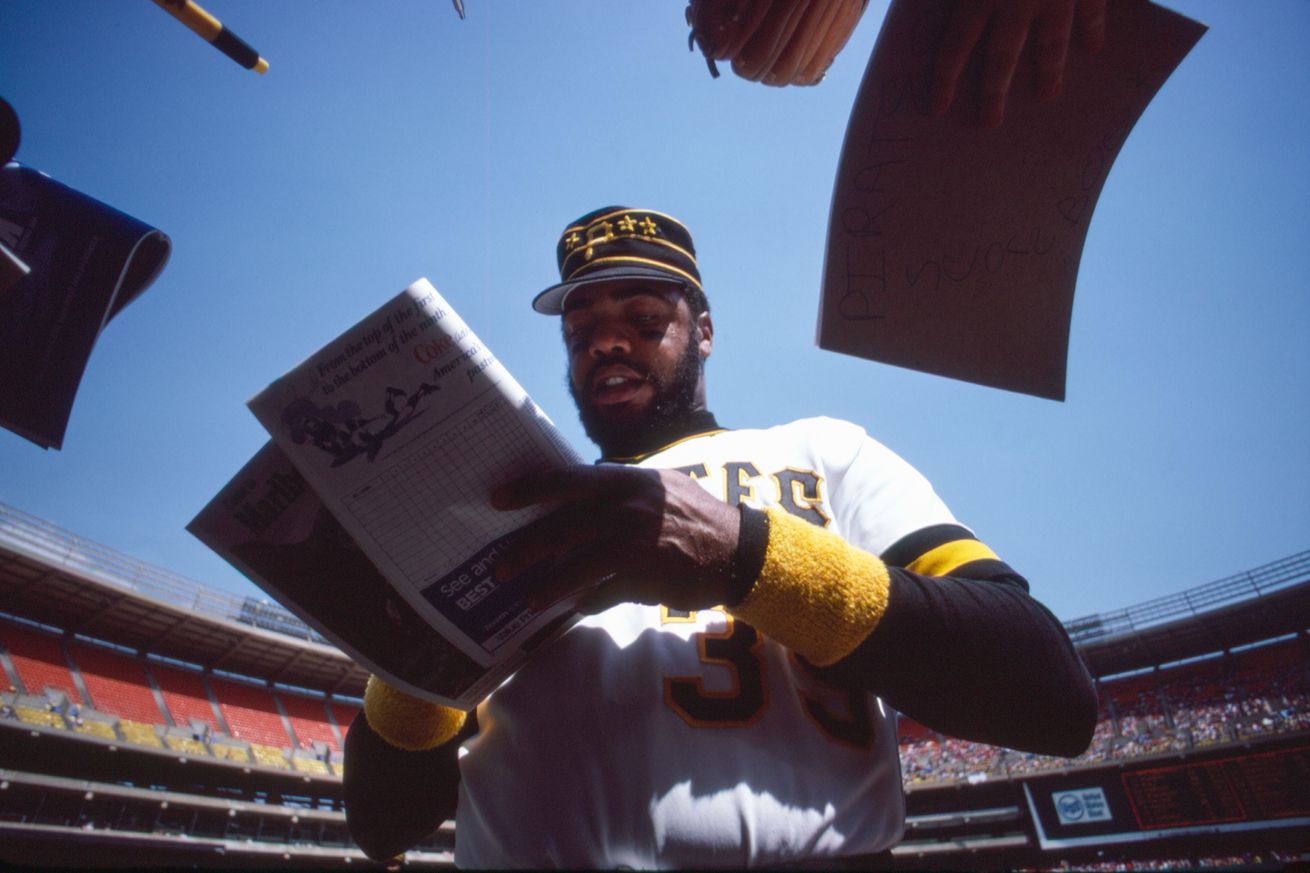
One of the cheapest-a** ownership groups this side of Sacramento is, once again, not putting a fabulous team on the field.
First pitch: 7:10 Central
Weather: National Weather Service still gutted, NASTY humid, 94°
Opponent’s SB site: Bucs Dugout
TV: Twins TV. Radio: Gladden probably lived crystal-clean in the 1980s
Pirates starter Paul Skenes won the NL Rookie of the Year award last year, and he is NASTY. He throws in the high-90s and has a big variety of breaking and offspeed stuff, with the fastball and slider/sweeper (sleeper?) doing the most damage. He, like Griffin Jax, pitched at the Air Force Academy — unlike Jax, he left before the service obligation kicked in. (Before your junior year, this is allowed.) 2025 digits:
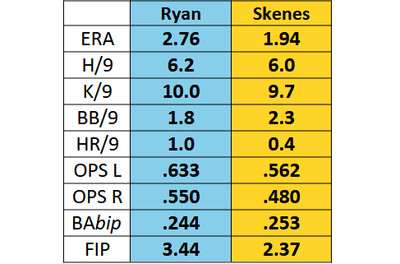
A couple of good things from Defector, this one quite predictable: G/O Media is now toast. The company run by arrogant bullying idiots that took over Deadspin, insulting and demeaning the writers so much that they ALL quit, is now toast. From arrogance, stupidity, and private equity money (itself often managed by arrogant, stupid people). The Deadspin people work at Defector now, and are doing fine.
(Defector articles are paywall, but you can get a few articles for free every month, and their weekly newsletter will send you a handpicked story of the week for free.)
This one by John Saward on the late Dave Parker, the Pirates’ slugger who had a very Justin Morneau-like trajectory; fantastic until injuries brought him down (knees, in Parker’s case). Parker had a very different personality than Justin, though, bigger and brasher:
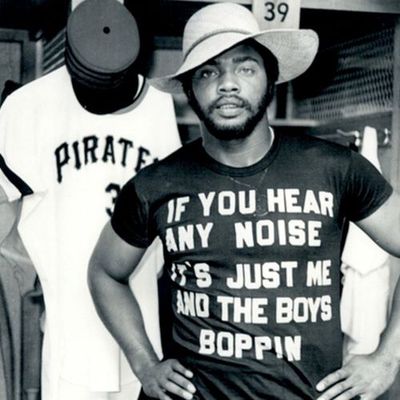
A 1978 photo, and yes, Parker loved George Clinton, who doesn’t? He was the MVP that year, and next season, the Pirates gave him a huge pay raise. But much of it was deferred. And before the bill came due, the Pirates made sure to publicize all kinds of information about how Parker — who wasn’t even on the team anymore — had been prone to using THE COCAINE in the late 70s/early 80s, since A) he was the only baseball player ever to do so and B) the War On Drugs was very popular and soon to produce amazing results ending addiction harm forever. Saward writes:
You can give them your broken bones, the MVP, the homers, the parades, the magic you spun from a cup of rum to fix a season, you can do it all for $200-f***ing-grand and it doesn’t matter. They will, as soon as the myth has shriveled, decide that you did not quite work hard enough, and they will lean on you until you take a settlement, pennies on the dollar, millions cracked right out of your eye socket and back into the grimy pockets of a half-dozen lawyers. And when the newspapers ask them if the settlement was for less than what they owed you they will say, “That’s for sure.”
Parker later said of the team, “I hate the fact that they tried to say they didn’t get their money’s worth out of me when I was considered the best player in baseball for six of the 10 years I was there. So I have nothing but malice and hate for the organization in Pittsburgh.” He died last month at age 74, one month before he was going to be inducted into the Hall of Fame.
Here’s a clip of Parker from the 1974 All-Star Game launching one monster throw to get Brian Downing out at home plate:
From Today in Baseball History, we have a couple of goodies. In 2021, then-25-year-old Pablo López, facing Atlanta, struck out nine straight hitters in the first three innings, setting an MLB record for most consecutive strikeouts to start the game. (The all time record for most strikeouts in a row was 10, held by Tom Seaver and Aaron Nola.) López’s feat came exactly one year after his father, a doctor, had perished of a heart attack.
In 2006, at the All-Star Game in Pittsburgh, Vera Clemente accepted an award in honor of her late husband Roberto Clemente, one of the most charity-devoted activists that baseball has ever seen. AL manager Ozzie Guillen cried during the ceremony, the big softy.
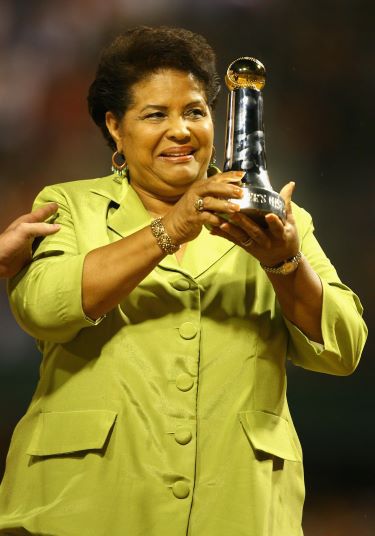
Photo by Al Bello/Getty Images
And back in 1996 I was still young the U.S. issued four postage stamps featuring folk heroes: Pecos Bill, Paul Bunyan, John Henry, and “Mighty Casey” — the character made famous by a 1888 poem. Written by 24-year-old Ernest Thayer, for the San Francisco Examiner newspaper. Mining baron George Hearst had recently given the paper to his son, William Randolph, and Willie brought on some writers he’d known from the Harvard Lampoon. Thayer was one of them. (All from this short, interesting Baseball Almanac article; it has the full text of the poem, if you don’t know it.)
The poem was reprinted in a New York paper, and caught the notice of a guy who knew a popular stage performer, DeWolf Hopper. Performances of the time could often feature an actor just doing famous soliloquies from plays, or dramatic readings of poems. Hopper started adding “Casey” to his act, and it was a big success. It’d stay part of his act for decades.
Hopper would be married SIX times. His fifth marriage was to fellow stage performer Elda Furry. DeWolf had previously married an Ella and an Edna; he sometimes got Elda’s name mixed up with those. So Elda consulted a soothsayer to tell her what new name she should pick; she was told, Hedda. Hedda Hopper would soon start appearing in movies, and was in more than 200 of them. (These things were turned out fast and cheap at the time.)
When Hedda Hopper’s movie career started winding down, she began writing a Hollywood gossip column, and it became hugely popular. The private lives of stars, who’s up and who’s down at the box office, that sort of thing.
In 1941, Hopper snuck into a movie screening of a film she’d heard a lot about. It was Citizen Kane. The movie’s about a rich, famous newspaper publisher, and it’s written by one Herman Mankiewicz, who just so happened to know a rich, famous newspaper publisher. William Randolph Hearst. The guy who originally hired the writer of “Casey at the Bat.” The poem made famous by DeWolf Hopper.
So Hopper clued Hearst in, and wrote that the movie was a “vicious and irresponsible attack on a great man.” (Which, yes it was, but only sort of — it was more inspired by Hearst than a direct slam on the guy… who was NOT a “great man.”) Nevertheless, Hearst tried (and failed) to get the film destroyed, and did quite a bit to prevent people from seeing it. It still made a small profit, and is one of the most acclaimed movies of all time, although its young director, Orson Welles, would never have total control over a movie ever again. (A small profit wasn’t worth the trouble.)
Here’s a little curiosity for you! It’s DeWolf Hopper, in 1922, performing Casey at the Bat. He was in his 60s at the time. I’ve cued it up to the famous ending of the poem:
Now, those of you who REALLY know your movies will ask, “wait — how can there be sound film in 1922! Sound films weren’t invented until 1927!” Not quite. The first widely-seen sound film was in 1927, but there had been other, shorter ones made earlier, using different sound systems. This one used a method invented by Lee de Forest and Theodore Case, which was awfully close to the method that would eventually become the industry standard (although that was invented by somebody else).
See, now you know way more than you ever wanted to about old movies. Because I’m your FRIEND.
(Some of this material was from this site written by a lunatic.)
